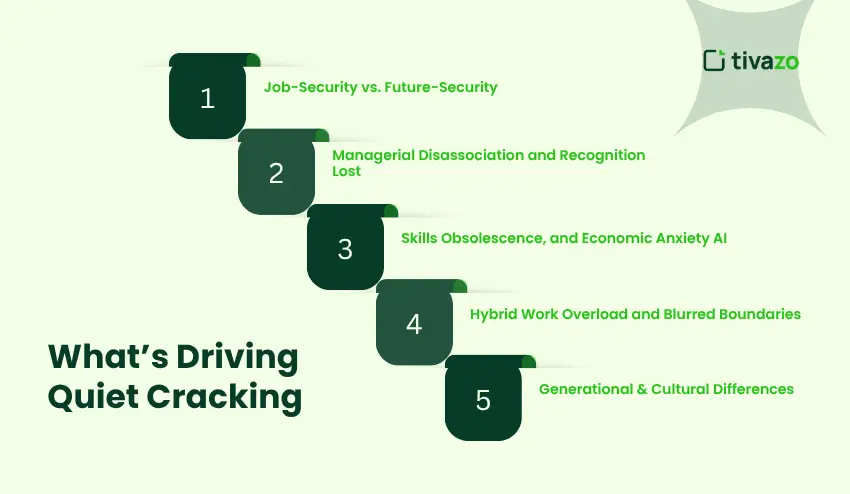The workplace has, over the last several years, been a nursery of quiet trends, namely quiet quitting, quiet firing, and quiet hiring. However, there is a new word that is stirring in 2025, quietly cracking. It is not merely a buzzword. It is the unspoken limit that employees would hit when the stress of performance and their mental strength do not match.
Silent cracking does not occur instantly. It is the gradual demoralization and loss of confidence under the strain of unrealistic demands, absence of encouragement, and overall stress to do more with less. To managers, it is simple to overlook until the productivity goes down, morale plummets, and brilliant employees mentally check out way before they submit their resignation.
In the present blog, we will unravel the true meaning of quiet cracking, its causes, and how this phenomenon is different to quiet quitting and burnout. You will get to know how to notice the first warning signs, what the data tells us about its effects, and most importantly, how the leaders can restore psychological safety before their teams silently disintegrate.
What Is Quiet Cracking?
Where quiet quitting is doing the bare minimum to defend oneself, quiet cracking is doing so within the boundaries. It is the time when employees are at a silent breaking point; they are still attending work, they are still working, but inside them, they are working on fumes.
The Meaning of Quiet Cracking.
Quiet cracking refers to the psychological pressure that accumulates when employees are caught between the growing expectations and the fading energy. Quiet cracking occurs in the background, unlike burnout, which is more evident and is openly discussed. Employees might seem busy on the surface, but inside, they are struggling to meet the workloads, expectations, or emotional demands.
This phrase was used following the TalentLMS 2025 survey of the workplace, which found that almost 57 percent of the workers believe that they are about to crack under the pressure of stress, absence of appreciation, or unhealthy performance expectations. This is simply what occurs when pushing through becomes the default coping strategy, which is known as quiet cracking.
Where the Term Originated
The term quiet cracking was first used in the research of the workforce that attempted to investigate the post-quiet quitting phenomenon. It is the consequence of a climate in which the employees no longer feel safe to share their plight, so, as opposed to stepping back, they fall into pieces in silence. This is the opposite of disengagement: individuals are continuing to struggle, but the struggle cannot be maintained.
Why It is Gaining Traction Now.
The mental health of the workplace is at a crossroads in 2025. The employee expectations have been transformed by post-pandemic recovery, hybrid work fatigue, and the necessity to adapt to new technology such as AI. Most of the employees are absorbing the pressure instead of resisting it.
The result? A healthy but unstable workforce, who seem okay in meetings but are secretly struggling with anxiety, fatigue, or self-doubt. Silent cracking is the new emotional undertone of the contemporary workplace.
The Magnitude and Effect of Quiet Cracking.
Silent cracking is not always noticed by the managers and the colleagues but its effects are far-reaching to individuals, teams, and the organization at large. Employees might be able to work, but the unspoken strain and lack of interest add up to effects that can eventually cost firms billions.
Key Statistics & Findings
The study of the TalentLMS 2025 survey indicates that more than 54 percent of the employees report that they have experienced the symptoms of quiet cracking, i.e. from the hidden anxiety to the lack of motivation. Funny enough, these employees still perform to the expectations and thus managers can hardly notice until the damage has been caused.
Other research shows:
Companies are losing up to 438 billion dollars in the world because of the disengaged employees who engage in quiet cracking habits.
Even with the appearances of competence, employees with quiet cracking report lower job satisfaction, lower innovation, and increased emotional fatigue.
The Business Fallout
Silent cracking kills productivity, teamwork, and retention. Teams can see minor indicators, such as deadlines missed, declining creativity or morale, but the cost is felt in months or years. For managers, this can mean:
- Increased turnover rates: The workers can move away without prior notice, having reached their breaking point.
- Cultural decadence: Team cohesion and trust in the organization are destroyed through silent disengagement.
- Innovation loss: Mentally checked out employees hardly ever take initiative or offer new ideas.
The Human Cost
To the employees, quiet cracking is experienced as:
- Constant stress and anxiety.
- Affective burnout with external performance.
- Stagnation in career because of less involvement, visibility or ambition.
What’s Driving Quiet Cracking
It is necessary to know the underlying reasons of quiet cracking so that both the managers and the employees who are interested in correcting it can do it before it grows out of proportion. The phenomenon is not caused by one thing; it is a combination of organizational stress, management loopholes, and personal stressors.

Job-Security vs. Future-Security
A lot of employees are stable in their current jobs but are concerned about the future. According to the survey conducted by TalentLMS 2025, 82 percent of respondents are safe in their present job, whereas 62 percent are sure about their further development. This fear puts an invisible stress: workers work harder to demonstrate their worth, and crack under the pressure silently.
Managerial Disassociation and Recognition Lost.
One of the major causes is the absence of supportive management. Even small setbacks may become chronic stress when employees feel unheard or undervalued. HR research findings indicated that 47 percent of employees who had quiet cracking said that their managers hardly recognized their efforts.
Skills Obsolescence, and Economic Anxiety AI.
The contemporary workplace is changing at a very high rate. Most of the employees worry that their skills might be rendered useless, and new technologies such as AI only exacerbate the stress. The uncertainty and inflation further complicate the situation, so quiet cracking is a mixture of individual and environmental stressors.
Hybrid Work Overload and Blurred Boundaries.
Remote and hybrid work arrangements may make the problem worse. The lack of boundaries between work and life usually results in increased working hours, being connected all the time, and psychological exhaustion. Employees can seem to be there and working, yet they are secretly trying to balance.
Generational & Cultural Differences.
Not all people respond to quiet cracking. The pressure on younger generations (Millennials and Gen Z) can be even stronger because of the increased demands of recognition, career progress, and meaningful work. There is also the influence of culture, where certain workplaces do not encourage any openness about stress or burnout.
The Manifestation of Quiet Cracking Early Warning Signs.
Silent cracking does not blow up overnight. It is insidious and usually disguised as productivity. Early detection of the signs will assist both the employees and managers in intervening before the situation gets out of control.
Subtle Behavioral Shifts
Even when employees silently crack, they can still finish their assignments, yet their involvement is undermined:
- Reduced attendance at meetings or brainstorming.
- Less volunteering and volunteering outside their work.
- Evading the confrontation or hard dialogue results in silent compliance.
Psychological and Emotional Red Flags.
Quiet cracking presents itself internally as:
- Constant worry, tension, or anxiety.
- Indifference to work or co-workers.
- Less strength in the presence of stress or frustrations.
Team-Level Indicators
Consequences at the team level may be evident to managers, even when individual behavior appears normal:
- Reduced teamwork or team integration.
- Reduced response time and initiative.
- Increasing tension or minor detachment of group dynamics.
Differentiating between Performance and Hidden Erosion.
Quiet cracking does not necessarily have an immediate impact on visible output as burnout does. Employees can be working excellently and silently draining their energy, confidence, and mental well-being.
Checklist: Are You Quietly Cracking?
- Employee self-diagnostic questions:
- Are you mentally tired of deadlines?
- Do you feel less motivated to give ideas or take the initiative?
- Are you always anxious about performance or the opportunities?
- Do you feel emotionally unemotional about your team or projects?
- Do you feel like you are just holding on and not thriving?
This checklist can be used by employees or managers to identify the initial signs and take the initiative.
Quiet Cracking Vs Quiet Quitting
Quiet cracking and quiet quitting are often mistaken for each other. They are, however, two fundamentally distinct concepts exhibiting important differences. Being able to tell them apart is critical both for employees and managers.

What Each Term Actually Means
Quiet Quitting: Employees are disengaged by only doing what is required of them and thereby setting boundaries without doing anything above and beyond. Essentially, this is a voluntary decision to decrease effort.
Quiet Cracking: Employees are still trying to give their best on the outside but are quietly cracking on the inside. This is often due to unrealistic expectations, a lack of recognition, or emotional stress.
Core Differences – Pressure vs Withdrawal
| Aspect | Quiet Quitting | Quiet Cracking |
|---|---|---|
| Motivation | Low engagement, preserving effort | High effort but under strain |
| Visibility | Noticeable reduction in contributions | Hidden; performance appears normal |
| Emotional State | Detachment, disengagement | Stress, anxiety, emotional fatigue |
| Cause | Boundary-setting, dissatisfaction | Overwork, pressure, lack of support |
| Manager Response Needed | Adjust workload, clarify expectations | Support, recognition, mental health |
Comparison of Underlying Causes
Often, quiet quitting is a result of not aligning with personal values and/or job expectations.
Quiet cracking is a result of both internal and external pressure, where an employee continues to execute at a high level but is close to a mental breakdown.
Confusion from Managerial Staff
Managers often misunderstand quiet cracking as performance or quiet quitting as being lazy. When differences are not addressed, it allows time for the problem to get worse. Understanding these nuances is critical for retention and morale.
Quiet Cracking vs Burnout
Quiet cracking and burnout are closely associated yet distinct experiences. Both impact the way employees function at work and their general well-being, but understanding the distinctions between the two is critical for appropriate action.
Key Concepts
Quiet Cracking: Employees seem to be functioning normally but are experiencing some form of strain. They may continue to meet expectations, deliver results, avoid culture, feel emotionally fatigued, feel anxious, or have a lower ability to bounce back than before.
Burnout: Employees often present open signs of (experiencing) exhaustion, decline in productivity and disconnected from work. Burnout is often the culmination of ongoing prolonged stress without support.
Comparison Table: Quiet Cracking vs Burnout
| Aspect | Quiet Cracking | Burnout |
|---|---|---|
| Visibility | Hidden; performance seems normal | Obvious; decline in output and energy |
| Emotional Impact | Stress, anxiety, inner tension | Exhaustion, cynicism, detachment |
| Physical Symptoms | Mild (fatigue, sleep changes) | Severe (chronic fatigue, illness) |
| Duration | Can persist unnoticed for months | Prolonged and often debilitating |
| Recovery Approach | Support, recognition, boundary-setting | Rest, workload reduction, therapy |
Why It Matters
Quiet cracking can lead to burnout if untreated. Workers may continue to “hold it together” at the office, despite deteriorating conditions. Thus, early detection is especially important for managers. Once a manager sees or picks up on the quieter signs of cracking, organizations to intervene before lower productivity, lower engagement, and lower morale set in.
The Price of Ignoring the Quiet Cracking.
Silent cracking cannot be seen, but its effects are not. Unchecked, it may silently undermine performance, morale, and well-being of organizations, teams, and employees at an unbelievable financial and cultural price.
Organizational Fallout
- Hidden Attrition: The gifted employees secretly exit or check out unannounced. The replacement costs such as recruitment and training can be huge.
- Decreasing Productivity: Although high performers can generate less in the long run, internal stress can impact team productivity and innovation.
- Culture Decay: Disengagement is contagious. Teams in which quiet cracking is not addressed tend to have low trust, ineffective communication, and reduced teamwork.
Individual Consequences
- Mental Health Strain: Stress may develop into anxiety, depression, or burnout after a long period of time.
- Career Stagnation: Employees might cease to seek new opportunities and thus fail to get promotions or skill development.
- Job Dissatisfaction: The longer the silent cracking is, the more the employees are likely to become disengaged completely, although they may not have left the company yet.
Macro & Financial Impact
According to surveys, disengaged employees who have a quiet cracking add to an annual loss of productivity of a staggering 438 billion in the world.
The long-term expenses are high turnover, lack of innovation, and damage of reputation, particularly within the talent-based industries.
Effective Methods to prevent or reverse Quiet Cracking.
Quiet cracking is an issue that needs to be dealt with proactively, involving both the managers and employees. The idea is to establish a place where pressure does not silently destroy people and to equip them with the means of bouncing back before things get out of control.
For Organizations
- Introduce Psychological Safety: Promote free communication and establish avenues through which employees can express their concerns without intimidation.
- Recognition and Reward Systems: Frequent appreciation of effort and not the results will lessen stress and affirm value.
- Workload Audits: Evaluate the work of employees to make sure they are expected to work realistically and not to be constantly overworked.
For Managers & Leaders
- Frequent Check-Ins: Brief, regular meetings can be used to measure emotional and workload wellness outside KPIs.
- Empathy-Oriented Leadership: The ability to see the situation and difficulties of the individuals does not allow the silent strain to grow.
- Facilitate Resources: Counseling, coaching, and flexible arrangements can be used to ensure that quiet cracking does not progress.
For Employees
- Establish Limits: Work on priorities and set specific boundaries of work and life so that pressure does not build up.
- Self-Monitoring: Take the checklist in the previous sections to identify the warning signs.
- Get Support: Before stress breaks, discuss it with managers, mentors, or mental health professionals.
Conclusion – Quiet Cracking Is a Signal, Not a Failure
Quiet cracking is a public health signal, not an indication of either personal or professional failure. It represents the cumulative pressures created by the demands of contemporary work, the divergence of expectation and support, and the invisible burden of sustained performance.
For employees, an early warning signal of quiet cracking affords the opportunity to be proactive with self-care practices, to set boundaries, and to seek out their support system, before stress escalates to burnout. For managers, understanding the more subtle indicators of quiet cracking provides an opportunity to intervene early, to reconnect and engage before burnout occurs, and ultimately to prevent the loss of top talent.
By recognizing quiet cracking and putting strategies in place, from psychological safety to managing workload to providing learning opportunities, the workplace can shift from a place of quiet suffering to one of productivity and sustainability for employees.




